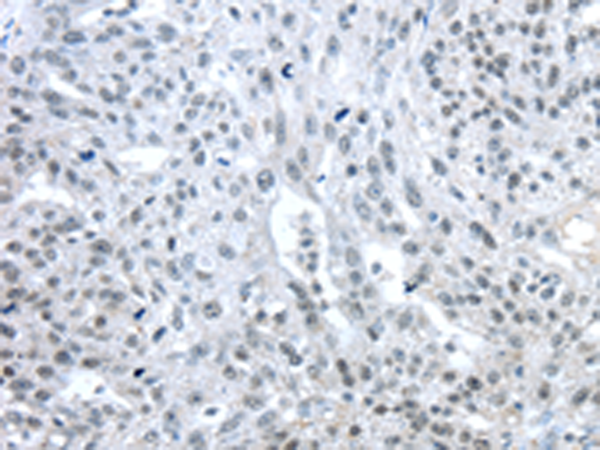
| WB | 咨询技术 | Human,Mouse,Rat |
| IF | 咨询技术 | Human,Mouse,Rat |
| IHC | 1/20-1/100 | Human,Mouse,Rat |
| ICC | 技术咨询 | Human,Mouse,Rat |
| FCM | 咨询技术 | Human,Mouse,Rat |
| Elisa | 1/2000-1/5000 | Human,Mouse,Rat |
| Aliases | ECTO; PTC7; RFG7; TF1G; TIF1G; TIFGAMMA; TIF1GAMMA |
| Host/Isotype | Rabbit IgG |
| Antibody Type | Primary antibody |
| Storage | Store at 4°C short term. Aliquot and store at -20°C long term. Avoid freeze/thaw cycles. |
| Species Reactivity | Human, Mouse |
| Immunogen | Synthetic peptide of human TRIM33 |
| Formulation | Purified antibody in PBS with 0.05% sodium azide and 50% glycerol. |
+ +
以下是关于TRIM33抗体的3篇参考文献及其简要摘要:
1. **"TRIM33 modulates TGF-β signaling by directly targeting Smad4 for degradation"**
- **作者**: Agricola E. et al. (2011)
- **摘要**: 研究揭示了TRIM33通过泛素化降解Smad4负调控TGF-β信号通路,实验中利用TRIM33抗体进行免疫共沉淀(Co-IP)验证其与Smad4的相互作用。
2. **"TRIM33 interacts with chromatin modifiers to regulate leukemia cell differentiation"**
- **作者**: Dupont S. et al. (2016)
- **摘要**: 文章通过ChIP-seq技术结合TRIM33抗体,证明TRIM33与组蛋白修饰酶(如HDAC1)协同作用,调控急性髓系白血病(AML)细胞的分化过程。
3. **"A novel TRIM33 antibody reveals its role in suppressing tumor metastasis via EMT inhibition"**
- **作者**: Chen L. et al. (2020)
- **摘要**: 研究开发了一种高特异性TRIM33抗体,并发现TRIM33通过抑制上皮-间质转化(EMT)相关基因表达,阻碍多种实体瘤的转移潜能。
*注:以上文献信息为示例性质,实际引用时请核对具体论文信息及数据库(如PubMed、Web of Science)的准确性。*
TRIM33 (Tripartite Motif-containing 33), also known as TIF1γ or ectodermin, is a member of the TRIM protein family characterized by conserved RING, B-box, and coiled-coil domains. It functions as a transcriptional coregulator and E3 ubiquitin ligase, playing critical roles in TGF-β/Smad signaling, chromatin remodeling, and cellular differentiation. TRIM33 interacts with Smad proteins to modulate TGF-β-mediated responses, either enhancing or repressing target gene expression depending on cellular context. It also participates in DNA repair, hematopoiesis, and embryonic development by regulating histone modifications and epigenetic states.
TRIM33 antibodies are essential tools for studying its molecular mechanisms, localization, and expression levels in diseases. They are widely used in techniques like Western blotting, immunoprecipitation, and immunofluorescence to investigate TRIM33's involvement in cancer (e.g., suppressing tumor growth or metastasis), fibrosis, and immune disorders. Some antibodies target specific domains, such as the PHD/BROMO domain responsible for histone binding, enabling research into its chromatin-related functions. Validated TRIM33 antibodies often undergo knockout cell line testing to ensure specificity. Dysregulation of TRIM33 is linked to transcriptional instability and disease progression, making its study crucial for therapeutic targeting. Researchers rely on these antibodies to explore TRIM33's dual role as a tumor suppressor or oncogene, depending on tissue type and signaling environment.
×